What are door latches for?

The operation of the door leaf involves frequent movement of the sash. This phenomenon can cause many inconveniences. There are several ways to deal with this problem. Before choosing one of the options, you should find out what the door latches are for.
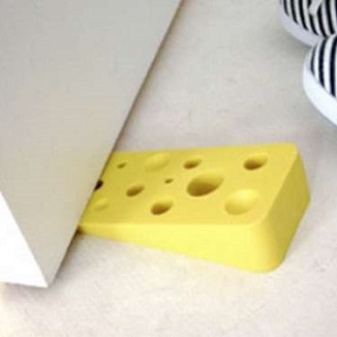
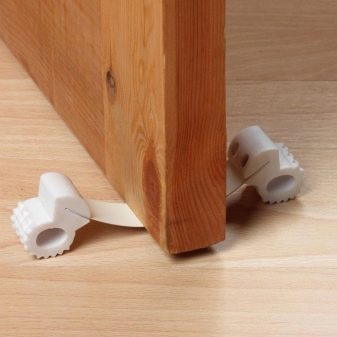
What is it and why is it needed?
Door position latches are devices that are installed on or near the door leaf in order to restrict its movement in a certain direction. Structurally, these elements can be different, since their design depends on the purpose.
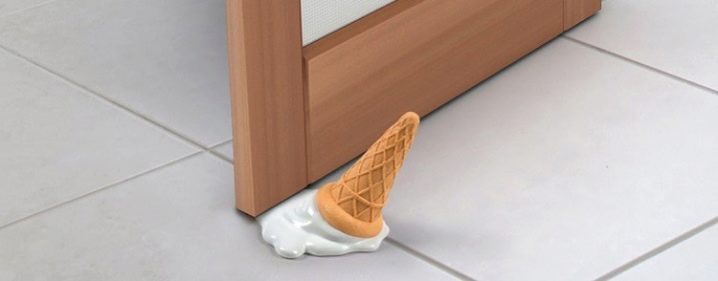
The simplest example is an ordinary rod that was inserted into the floor in the path of the doors. He only allowed her to swing open to a certain angle. Door restraints are used for various purposes:
- Protection from injury. The main purpose of the holders is to protect a person from accidental slamming of doors. This is especially true if there are small children in the house who will not be able to open the canvas from the inside if it is accidentally closed. They also protect the incoming person from accidental blows. This can happen due to the fact that someone from the inside will suddenly open the door or the canvases will simply begin to move under the influence of a draft.
Such mechanisms are perfect for interior designs.
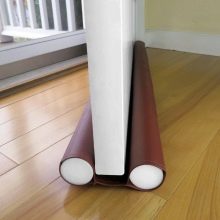
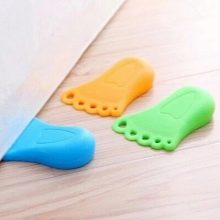
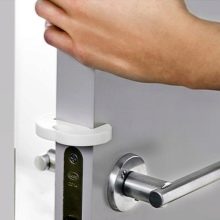
- Protection of furniture from damage. Very often, a wardrobe, bedside table or mirror can be located in the path of the door leaf. If you open it, then an impact can destroy the structure or simply damage the decorative layer. Therefore, it is better to install the retainer and forget about this phenomenon.
- Door hardware protection. If the doors are opened to the maximum angle, then this proportionally increases the load on the hinges, so many people install limiters so as not to think about this phenomenon and keep the fittings for a long time.
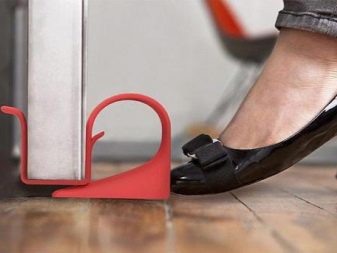
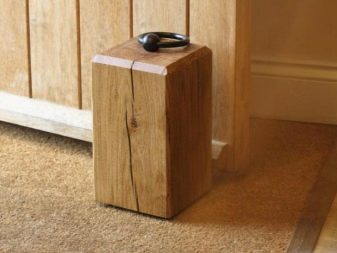
Views
Technically, latches are small structures that can be installed under a door or on a door to restrict its movement.
Depending on the location, several types of limiters can be distinguished:
- Wall mounted. Install them directly on the wall in order to avoid hitting the doors on it.
- Outdoor. Structures of this type are special wedges that prevent the movement of the blade. With their help, you can install the door in almost any position.
- Over-the-wall. These mechanisms allow you to limit the movement of the sash, as well as smoothly return it to the closed position.
- Opening limiters. These systems do not allow the doors to swing open without permission.
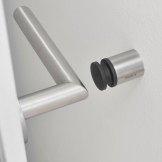
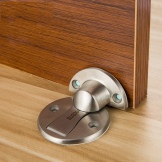

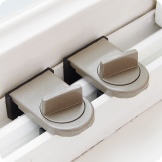
Latches for locking the door can be divided into the following types:
- Roller. Such a product is a small barrel, which, when the door is closed, falls into a special groove and does not allow it to move back. This ball system is fixed with a spring mechanism.
- Fale. This type of restraints is very similar to the previous model, but here they already use a special beveled tongue instead of a cylinder.
- Magnetic. Modern modifications that are installed on plastic or glass doors.
- Latch. This is the oldest retainer that has been used by humans for a very long time. It consists of a hook-shaped locking element attached to the wall. To restrict movement, this hook simply clings to a handle or other special device on the canvas.
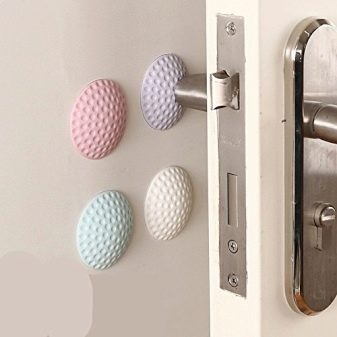
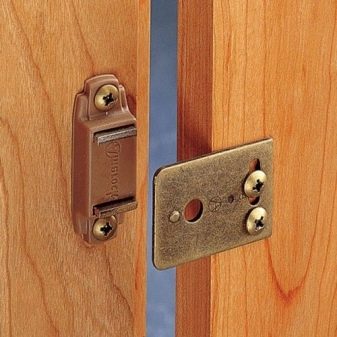
All these types of clamps are furniture, in turn. They can also be used for installation on sliding doors.
Floor restraints are of several types:
- Magnetic. These products are special units with a built-in magnet. In this case, a metal insert is installed on the door leaf, which interacts with the floor system. Such structures can be portable or stationary.
- Limiters. The simplest products that are installed on the path of the door. They do not allow it to open further than the established structure. But at the same time, ordinary limiters do not hold the canvas, so it can arbitrarily move in the opposite direction.
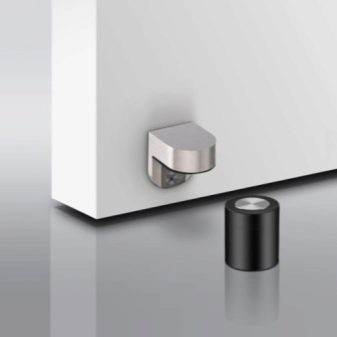
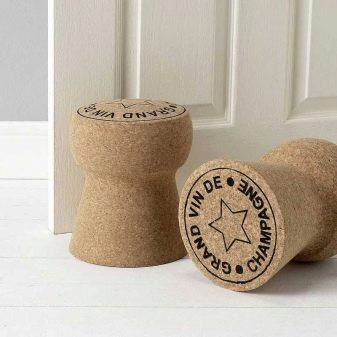
- Wedges. This retainer is of the portable type. To fix the canvas, simply insert a wedge under the door. The simplest version of a product that you can make yourself by sawing out of wood or cutting out of dense rubber.
- Legs. This stopper is equipped with two supports that are attached to the bottom of the door. When the canvas is opened, they are constantly pressed to the floor, therefore, when the system is stopped, they fix it and do not allow it to move in any direction.

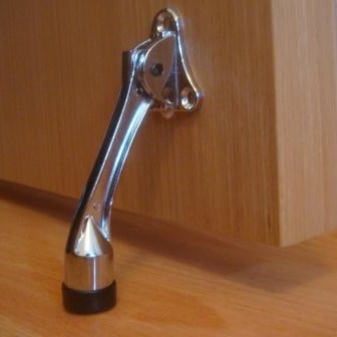
As for the wall models, they are systems that can restrict both the opening and closing of doors.
Conventionally, similar structures can be divided into the following types:
- Restraints for direct wall mounting. Externally, they can be of various shapes and sizes. They are made of soft materials so that the structure does not damage the door leaf on impact.
- Clamps mounted on platbands. These products can change their position in such a way that in one of them the doors will close, and in the other - they restrict the movement of the system.
Over-door models of latches are elements that are installed on top of the door. The simplest option is a C-shaped elastic band that can be worn on the top end.
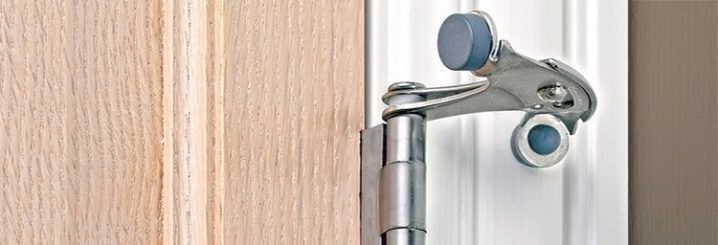
There are also special pedal stops that allow you to stop the web in any position. To continue driving, you will need to act on the pedal, which will release the latch.
Original forms
The peculiarity of the door latches is their original design. Today, manufacturers produce many varieties of similar products. On the market, you can find designs in the form of a goat's leg or an animal's leg. Horseshoe-shaped products are especially popular among over-door clamps. The selection of these products is very wide. You can purchase a design in the form of a small animal (rabbit, mouse, etc.), an unusual doll or a car.
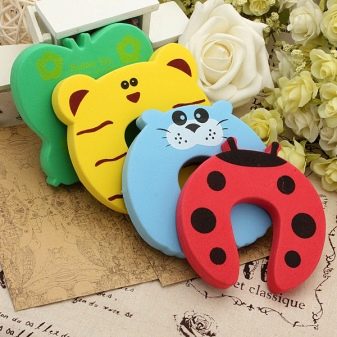
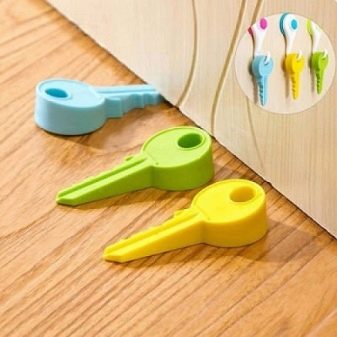
There are also non-standard modifications in which the design is associated with abstraction and is not associated with household items or animals. Choose details for the design features of the room, taking into account also the tastes of the inhabitants of the house.
Materials (edit)
The quality of the retainer depends not only on its design, but also on the material from which it is made.
Today they are obtained from several types of substances:
- silicone;
- rubber;
- aluminum and steel;
- plastic.
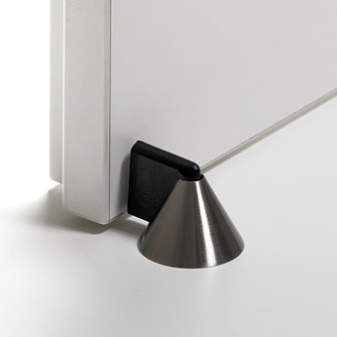
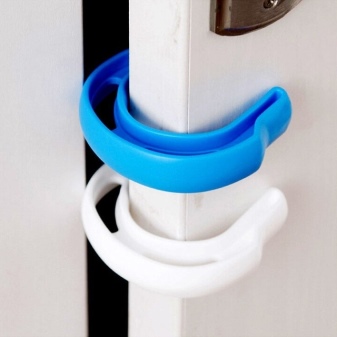
Sometimes products can be decorated with wooden inserts, but this material is not the main one. For wooden doors, experts recommend using steel or aluminum stoppers (floor version), which are protected by rubber inserts. When you need to choose devices for wall mounting, then silicone counterparts are the best option. This substance is not only soft, but also practically does not damage the structure of the canvas.
If you need to install a retainer in the bathroom, then give preference to magnetic counterparts. It is important that these devices are hidden in a plastic case, which will not allow moisture to enter and corrode the metal.
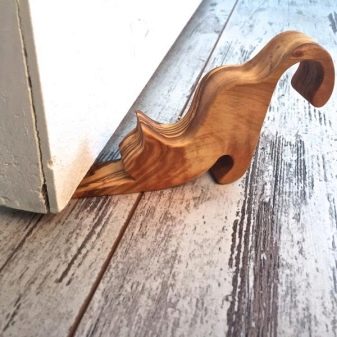
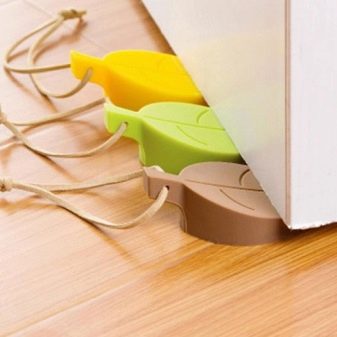
For glass doors, special furniture stops should be used. They will prevent the structure from breaking when plowing.Today these designs are represented by special mechanical latches and magnetic stops. In this case, it will be possible to release the canvas only by turning a special element.
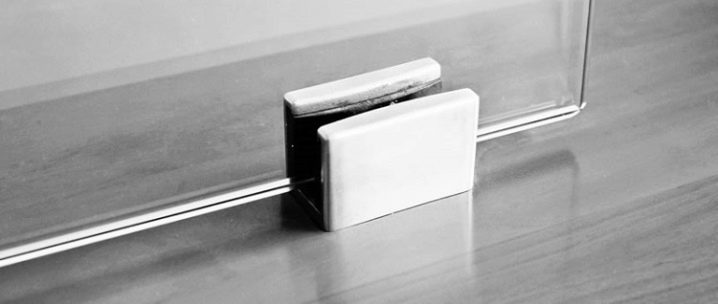
Installation subtleties
Today, almost all types of fasteners are equipped with special holes for fasteners. This greatly simplifies their installation and makes it possible to carry out it yourself.
When installing wall restraints, you should follow a few simple guidelines:
- The device must be mounted as close as possible to the end of the door leaf. This will prevent damage from frequent blows.
- Do not mount the system in front of the hinges, as this may affect their functionality.
- Be sure to consider the dimensions of the handle. It is important that it does not hit the wall after installing the clip.

Installation of floor restraints also has its own nuances:
- When choosing a place on the floor for the retainer, you need to take into account the length of the handle, so be sure to compare these values when choosing a location for the device.
- The latch also needs to be installed closer to the end. If this is not done, then over time the door will simply deform and lose its decorative properties. In some cases, it can be skewed, and it will no longer fit in the box.
- Position the guards so that the passage width remains as wide as possible. This will maximize your comfort while minimizing the chance of injury from accidental impact.

The algorithm for attaching such clamps is quite simple and consists of the following steps:
- Initially, you need to decide on its location. After that, using a pencil, mark the points for the mounting holes.
- In the marked places, you need to drill holes for the dowel. When everything is ready, the clamps are simply screwed to the floor or wall with self-tapping screws. Please note that if one of the surfaces is wooden, then the stoppers can be fixed immediately without forming holes.

Examples in the interior
Of course, you can use a regular wood or plastic retainer, but it's much better to use something more original! Many people will like the catches in the form of animal figurines - they look cute and can be a great addition to the interior. The original retainer in the form of a woman's leg in a striped stocking and a red shoe is likely to appeal to people with a good sense of humor. Not every person can afford to hold the door with an ingot of gold or a wad of money, but thanks to the ingenuity of the manufacturers, it is available to everyone, even not too rich homeowner!
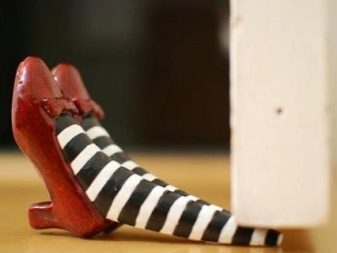
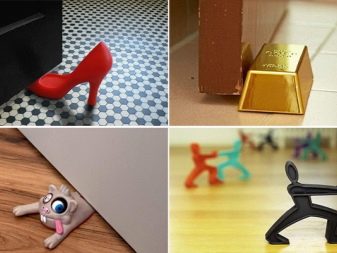
For information on how to make a simple do-it-yourself door lock, see this video.













The comment was sent successfully.